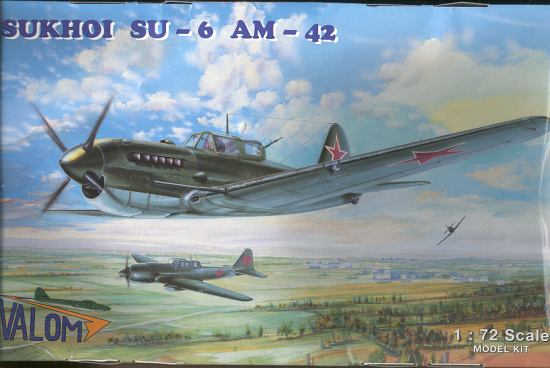
Valom 1/72 Su-6 (AM-42)
|
KIT # |
72001 |
|
PRICE: |
$29.95 MSRP |
|
DECALS: |
One aircraft |
|
REVIEWER: |
|
|
NOTES: |
Short run with etched metal fret. |

|
BACKGROUND |
Please visit the preview to get more info on the plane and the kit.

|
CONSTRUCTION |
First I must say that this is the first kit from Valom. I've come to expect initial models from these smaller companies to be a bit, well, difficult to build. Though it is better than some, it really is no exception to my experience in these areas. Not to say that it's impossible, just that you need 'experienced' modeling skills to be successful. It even says on the box that this kit is for experienced modelers so there should be no surprise.
I started, as it is pretty normal to do, with the cockpit. This consists of the tub into which various bits are added. In this case, there is a central bulkhead that needs some care when installing. The diagram shows a vertical section in the tub to which it should be attached. This is only true if you make it vertical. A bit of carving is all that was needed to provide it the vertical attachment point it needs. I then attached the seat back to it, having totally missed part #33, a small square seat post. Part of this problem is that all of the part number and paint number guides are very large and really make a clutter of things. I'd highly suggest redoing this aspect of the instructions by not only making the IDs smaller, but by making the color ones in a reverse color or something. All of the etched instrument panels were attached using clear paint and held up very well.
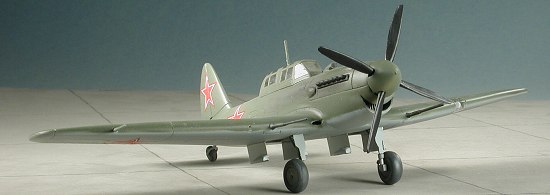 Anyway, I finally got all the cockpit bits attached and then
glued the cockpit to the left fuselage side, the only place where any attachment
marks were located. A problem arose when I test fitted the other fuselage side.
You see, the cockpit tub tapers a lot towards the rear, while the
fuselage taper in this area is not as great. I had a large gap on the right
side. This is somewhat compounded by the aft cockpit bulkhead being too wide for
the aft fuselage and not being tall enough to reach the cockpit tub. Much
sanding of this aft bulkhead was needed before I could get the fuselage halves
to fit together.
Anyway, I finally got all the cockpit bits attached and then
glued the cockpit to the left fuselage side, the only place where any attachment
marks were located. A problem arose when I test fitted the other fuselage side.
You see, the cockpit tub tapers a lot towards the rear, while the
fuselage taper in this area is not as great. I had a large gap on the right
side. This is somewhat compounded by the aft cockpit bulkhead being too wide for
the aft fuselage and not being tall enough to reach the cockpit tub. Much
sanding of this aft bulkhead was needed before I could get the fuselage halves
to fit together.
With the fuselage together, I painted the interior with light gull grey. I know that the Russians used a variety of paints for this purpose and so I figured one grey was as good as another. Once that was dry, the instrument panels were painted black and the strap that was the gunner's seat was installed. This is a photo-etched part and was a real bear to get in properly. The instructions would have you glue one side to a fuselage half, then join the fuselage and then attach the other side. I should have done just that. It was then painted leather and when dry a bit of dry-brushing was done.
My attention was then focused on the intake and the wings. The intake is to have the radiator grille attached to it and then glued to the lower forward fuselage. Well, it just didn't seem to fit that well so after a bit of 'adjustment' with sanding sticks, I got it to where it fit. The grille seemed to be designed to fit to the back of the intake section. Rather odd, but I glued it in place. It didn't fit. Out came the scissors and 'adjustments' were made to the etched grille before it finally fit well. Then it was glued to the back of the intake piece and the section glued in place. Several sessions with filler followed.
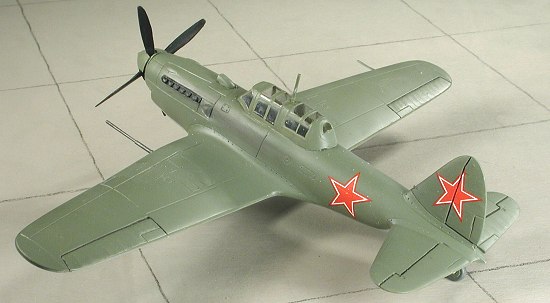 Meanwhile,
I glued the upper wings to the lower wing section. Fit is fairly good and was
enhanced by the soft plastic and use of 'hot' glue such as Ambroid Pro-Weld. The
trailing edges of the wings are a bit on the thick side, but not really that
bad. Once the wing was dry, it was glued to the lower fuselage. Well, things
turned a bit ugly when this occurred. Frankly, the fit of the wing is not good.
It isn't impossible, but just getting it on square and somewhat flush with the
surrounding areas took sanding sticks and some plastic strip to fill a gap or
two on the wing roots. Now I may have missed something in the construction of
the fuselage, but it was too late to go back now. Many loving ministrations with
filler then followed. I should mention that there are two intakes on the leading
edge of the wing next to the fuselage. These are to be made by the joining of
the wing to the fuselage. It didn't work well at all. I'd highly recommend
filing these intakes with plastic rod and then drilling out the intakes later.
You'll be glad you did.
Meanwhile,
I glued the upper wings to the lower wing section. Fit is fairly good and was
enhanced by the soft plastic and use of 'hot' glue such as Ambroid Pro-Weld. The
trailing edges of the wings are a bit on the thick side, but not really that
bad. Once the wing was dry, it was glued to the lower fuselage. Well, things
turned a bit ugly when this occurred. Frankly, the fit of the wing is not good.
It isn't impossible, but just getting it on square and somewhat flush with the
surrounding areas took sanding sticks and some plastic strip to fill a gap or
two on the wing roots. Now I may have missed something in the construction of
the fuselage, but it was too late to go back now. Many loving ministrations with
filler then followed. I should mention that there are two intakes on the leading
edge of the wing next to the fuselage. These are to be made by the joining of
the wing to the fuselage. It didn't work well at all. I'd highly recommend
filing these intakes with plastic rod and then drilling out the intakes later.
You'll be glad you did.
With the wing in place, the horizontal stabs were glued in. No real problem here and the fit was fairly good. Two canopies are provided in case you mess one up. I found the plastic to be a bit less rugged than I'd hoped and managed to crease the upper windscreen section on both of them. I chose the less mangled of the two to place on the fuselage. I didn't drill out the rear gun portal as I feared really messing things up, so my Su-6 has no rear protection. The fit of the canopy was fairly good, just barely covering the opening, so don't do any additional filing/sanding of the cockpit opening if you want your canopy to fit. It was then masked with tape. I should have faired it into the surrounding bodywork, but was fearful of doing major damage to it during the inevitable sanding process so didn't.
I then turned to the landing gear. Now, you have to realize that this is a short run kit and the plastic used on the main airframe is quite thick. This makes for a rather hefty aircraft. The landing gear are near scale in thickness, which means they are a touch fragile looking. I glued the tail wheel leg in place after opening the hole for it. The main gear were slipped in place and glued in. An etched part of the landing gear retraction strut is supposed to attach to a plastic rod on one end and the gear leg on the other. I just couldn't figure it out and so went with attaching the plastic rod straight to the gear leg. In this way, I added some strength to a rather weak construct. I must tell you that I treated the landing gear very gingerly throughout construction, fearing a breakage.
 The wheels were glued together and
then the tread sanded. The pitot tube was also installed at this time. Moving to
the prop, the prop blades were a bit difficult to remove from the sprue as the
attachments are quite short. They needed quite a bit of cleanup on the hub area
in order to fit into the spinner back plate. Once this was done the spinner
itself was glued in place. To my eye, the spinner isn't deep enough as it does
not totally cover the back plate. Yet it is too wide to be glued to the top of
the back plate, if you get what I mean.
The wheels were glued together and
then the tread sanded. The pitot tube was also installed at this time. Moving to
the prop, the prop blades were a bit difficult to remove from the sprue as the
attachments are quite short. They needed quite a bit of cleanup on the hub area
in order to fit into the spinner back plate. Once this was done the spinner
itself was glued in place. To my eye, the spinner isn't deep enough as it does
not totally cover the back plate. Yet it is too wide to be glued to the top of
the back plate, if you get what I mean.
The gear doors are made
of etched brass. This is good as it means they are nice and thin. There are
fairings that go on each one of the four major main gear doors. These fairings
are made of plastic. They are not well shaped and were a chore for me to glue to
the doors. The end result is not pretty at all. They are not as long as
what is shown in the drawings. What is more, there seems that there should be a
small piece on the forward door for these fairings to blend into. There isn't.
The box art is no help. 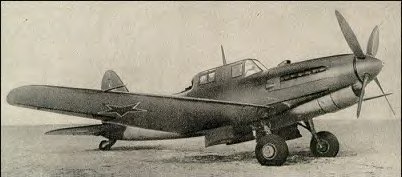
I should take this opportunity to talk about the kit vs the box art. They are not exactly the same. If you look at the nose of this model and the box art, there is a difference. The box art also doesn't show any of the fairings for the gear door. If you compare the model with a photo of the real plane shown here, you'll see that there is a much greater resemblance, but things are still not quite the same. This is true of the landing gear thickness and gear doors as much as anything else.
|
CAMOUFLAGE & MARKINGS |
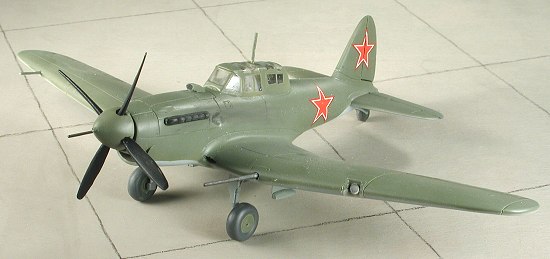 At this stage, I thought it a good
idea to slap on some paint. Grabbing what little is left of my Aeromaster Enamel
stash, I painted the upper in Russian Topside Green and the Lower in Russian
Underside Blue. A quite easy task. I chose to paint the wheel wells with dark
gull grey as much as to darken them up so you wouldn't notice that there wasn't
much there as anything else. When it came to decals, that was very simple. The
kit comes with insignia. Period. The plane had insignia. Period. The decals are
very good; quite thin and succumbing to Solvaset (Microsol had little impact on
them). Prior to applying the decals, I did spray clear acrylic gloss to the
appropriate areas. Oh yes, the prop spinner was painted Topside Green as were
the wheels. It seems as if green is a standard color for Russian wheels.
At this stage, I thought it a good
idea to slap on some paint. Grabbing what little is left of my Aeromaster Enamel
stash, I painted the upper in Russian Topside Green and the Lower in Russian
Underside Blue. A quite easy task. I chose to paint the wheel wells with dark
gull grey as much as to darken them up so you wouldn't notice that there wasn't
much there as anything else. When it came to decals, that was very simple. The
kit comes with insignia. Period. The plane had insignia. Period. The decals are
very good; quite thin and succumbing to Solvaset (Microsol had little impact on
them). Prior to applying the decals, I did spray clear acrylic gloss to the
appropriate areas. Oh yes, the prop spinner was painted Topside Green as were
the wheels. It seems as if green is a standard color for Russian wheels.
|
FINAL CONSTRUCTION |
 With the markings on, I turned my
attention to the other bits. The big guns had to have the holes in the wing
drilled out more to get them to fit. Yes, they are supposed to be that long. The
small landing light was glued in place, but the light covers (four are provided)
are way too narrow. I substituted a piece of gloss tape for the cover after the
model was flat coated. The wheels have the centers where the axles attach
off-center. Tail wheel is the same. There is one spot where you can have them to
where they look right. The wheels are also a strain on the thin landing gear.
Exhaust fit right into the recesses on the nose.
With the markings on, I turned my
attention to the other bits. The big guns had to have the holes in the wing
drilled out more to get them to fit. Yes, they are supposed to be that long. The
small landing light was glued in place, but the light covers (four are provided)
are way too narrow. I substituted a piece of gloss tape for the cover after the
model was flat coated. The wheels have the centers where the axles attach
off-center. Tail wheel is the same. There is one spot where you can have them to
where they look right. The wheels are also a strain on the thin landing gear.
Exhaust fit right into the recesses on the nose.
The gear doors were not much of a problem to fit in place. I use Acrabond superglue and find it to be an excellent material in terms of holding. Much better than standard superglues. While the gear doors fit well, they are ugly, thanks to the mess I made attaching the fairings. The radio mast was tacked on and the prop forced onto the prop shaft. The model then given a coat of clear acrylic matte and then the tape taken off the canopy. Finally, I did a bit of pastel soot for the engine area and the kit was done.
Wait a minute! What about the bombs? Uh, ok, I didn't put them on. Each bomb is two oval case halves with etched brass fins. It just didn't work out well at all. I made a terrible mess of one of them. Add to it that the bomb shackles are n'ere more than etched brass 'thingies' that I couldn't see being strong enough to hold the bombs and the instructions were rather vague about just where these shackles fit......... Anyway, bottom line is that I didn't put them on.
|
CONCLUSIONS |
OK, so you get the impression that the model wasn't perfect. That is true. You get the impression that it was difficult to build. That was true for me. I need to mention a couple of things. First, this is Valom's first kit. It is tough to get things right the first time out. Just look at Trumpeter, a company with a lot more resources than Valom. Secondly it is, in all respects, a short run kit. These kinds of kits are held to different standards than one does Revell or Heller.
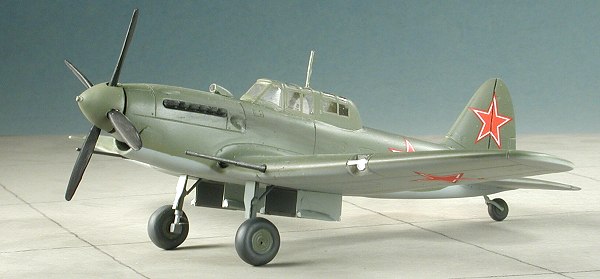 Things to work on.
First of all, make sure that the kit matches the plane as much as possible. This
one doesn't do a bad job in that respect, but as you can see from the photo, it
misses a bit in the nose and gear areas. Secondly, this combination of etched
brass and plastic such as in the gear retraction struts and gear doors just
doesn't work for me. I'd much rather have thick doors with the fairing molded in
than do it this way. Etched brass is not a cure-all for mold engineering
problems. I'd also rather have the bombs and racks in plastic or even resin than
in etched brass. I'm not that fond of it and so that may be coloring my
objectivity. A third thing is general engineering of parts. The wing and those
intakes comes to mind. I'd rather have an insert or a flat wall to drill out
than the method used for the intakes and the wing just didn't fit well, neither
did the interior.
Things to work on.
First of all, make sure that the kit matches the plane as much as possible. This
one doesn't do a bad job in that respect, but as you can see from the photo, it
misses a bit in the nose and gear areas. Secondly, this combination of etched
brass and plastic such as in the gear retraction struts and gear doors just
doesn't work for me. I'd much rather have thick doors with the fairing molded in
than do it this way. Etched brass is not a cure-all for mold engineering
problems. I'd also rather have the bombs and racks in plastic or even resin than
in etched brass. I'm not that fond of it and so that may be coloring my
objectivity. A third thing is general engineering of parts. The wing and those
intakes comes to mind. I'd rather have an insert or a flat wall to drill out
than the method used for the intakes and the wing just didn't fit well, neither
did the interior.
The company is off to a fairly good start with this kit. The subject is interesting and unusual. A bit more attention needs to be paid to fit and I think they'd have it licked. I can only hope that the next kit is even better than this one and I look forward to trying it out.
March 2003
#1260 in a series
Copyright ModelingMadness.com
Review kit from the fine folks at Valom. Thank you for your support.
If you would like your product reviewed fairly and fairly quickly, please contact the editor or see other details in the Note to Contributors.
Back to the Reviews Index Page 2017